The Kaveri Refresh 'Godavari' Review: Testing AMD's A10-7870K
by Ian Cutress on June 1, 2015 11:59 AM ESTOffice Performance
The dynamics of CPU Turbo modes, both Intel and AMD, can cause concern during environments with a variable threaded workload. There is also an added issue of the motherboard remaining consistent, depending on how the motherboard manufacturer wants to add in their own boosting technologies over the ones that Intel would prefer they used. In order to remain consistent, we implement an OS-level unique high performance mode on all the CPUs we test which should override any motherboard manufacturer performance mode.
All of our benchmark results can also be found in our benchmark engine, Bench.
Dolphin Benchmark: link
Many emulators are often bound by single thread CPU performance, and general reports tended to suggest that Haswell provided a significant boost to emulator performance. This benchmark runs a Wii program that raytraces a complex 3D scene inside the Dolphin Wii emulator. Performance on this benchmark is a good proxy of the speed of Dolphin CPU emulation, which is an intensive single core task using most aspects of a CPU. Results are given in minutes, where the Wii itself scores 17.53 minutes.
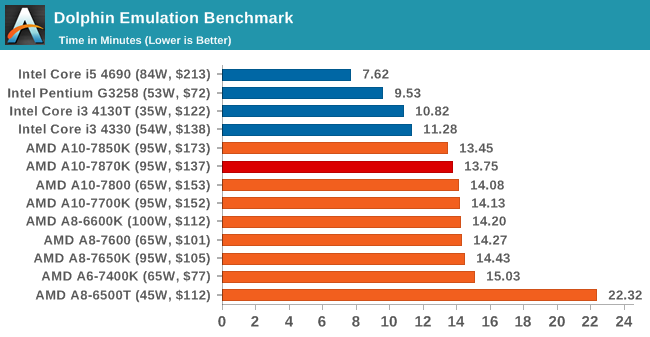
WinRAR 5.0.1: link
Our WinRAR test from 2013 is updated to the latest version of WinRAR at the start of 2014. We compress a set of 2867 files across 320 folders totaling 1.52 GB in size – 95% of these files are small typical website files, and the rest (90% of the size) are small 30 second 720p videos.
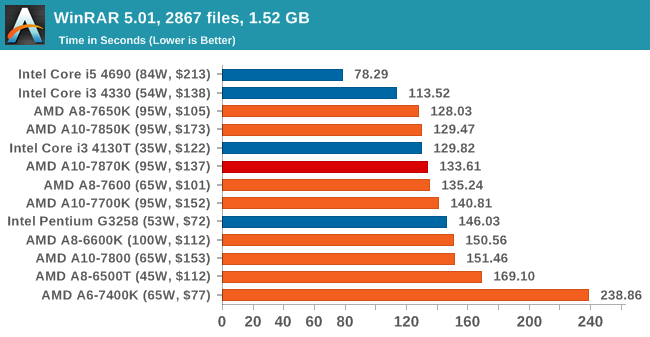
3D Particle Movement
3DPM is a self-penned benchmark, taking basic 3D movement algorithms used in Brownian Motion simulations and testing them for speed. High floating point performance, MHz and IPC wins in the single thread version, whereas the multithread version has to handle the threads and loves more cores.
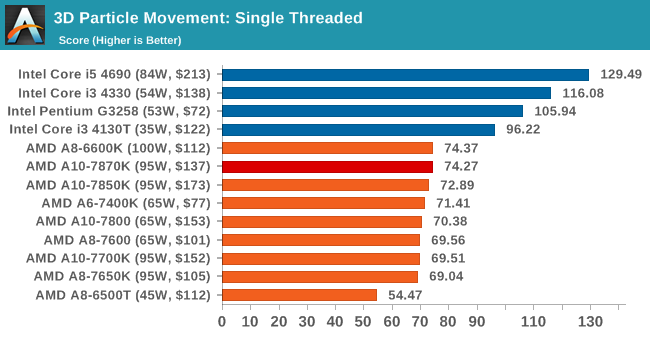
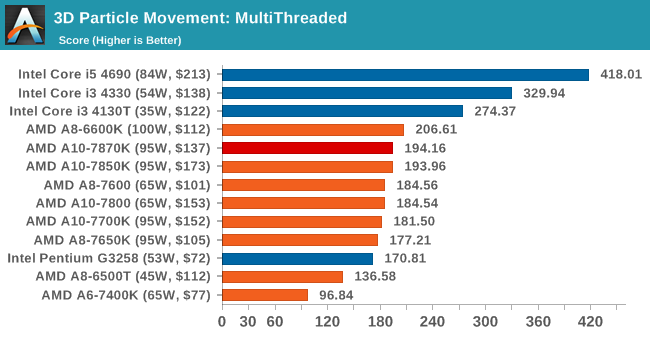
FastStone Image Viewer 4.9
FastStone is the program I use to perform quick or bulk actions on images, such as resizing, adjusting for color and cropping. In our test we take a series of 170 images in various sizes and formats and convert them all into 640x480 .gif files, maintaining the aspect ratio. FastStone does not use multithreading for this test, and results are given in seconds.
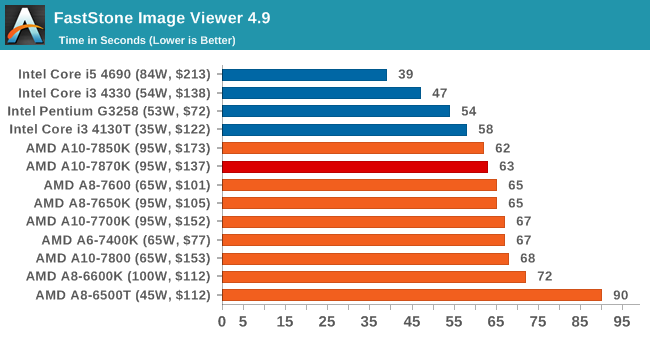
Web Benchmarks
On the lower end processors, general usability is a big factor of experience, especially as we move into the HTML5 era of web browsing. For our web benchmarks, we take four well known tests with Chrome 35 as a consistent browser.
Sunspider 1.0.2

Mozilla Kraken 1.1
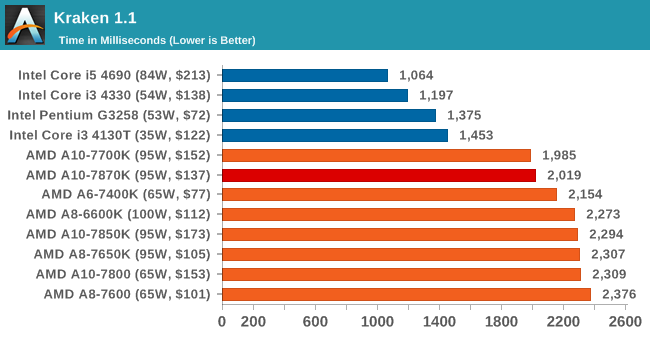
WebXPRT
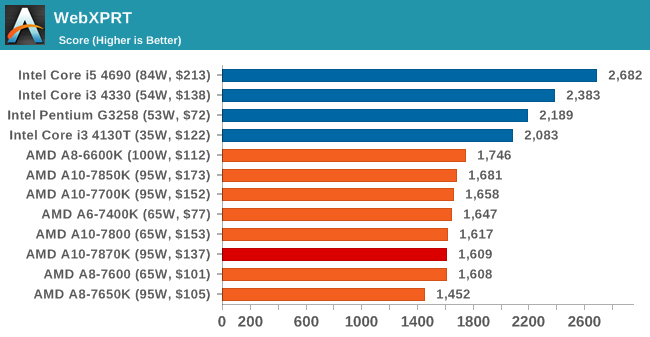
Google Octane v2
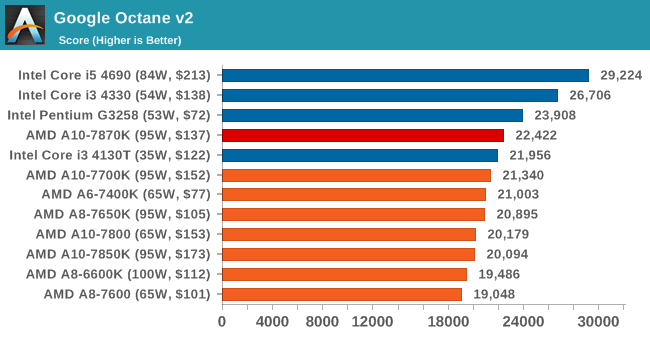










140 Comments
View All Comments
nikaldro - Tuesday, June 2, 2015 - link
"IT'S CORE COUNT I TELL YOU!!! NOW GO AND BUY THAT XEON E7! GREAT VALUE!!!!"Crunchy005 - Monday, June 1, 2015 - link
Outside of CPU results the Gaming results are all over the place. The 7700k beats out the 7870k sometimes and the APUs beat our the i5 at times. There is so much difference between games at the low end it's ridiculous.Lolimaster - Monday, June 1, 2015 - link
Outside of some results I think the 7870K gpu boost is bottlenecked by DDR3 bandwith, how about testing the 7850K/7870K both with 2133 and 2400/2600 DDR3.Pissedoffyouth - Monday, June 1, 2015 - link
Sorry to be a pain, but I think you meant GDDR5 rather than GDDR3 on the first page.LarsBars - Monday, June 1, 2015 - link
Great review, great coverage. I've been looking over the smorgasbord of leaks for the past few weeks wondering what is real and what is fake. Thanks for your high standards in tech reporting.Shadowmaster625 - Monday, June 1, 2015 - link
Clearly there is something wrong, since a supposedly faster chip comes in slower on many benchmarks. Sunspider being the most egregious offender. Perhaps the instructions used in the sunspider benchmark cost a lot of power, which leads to even more pronounced throttling. At any rate, why is this throttling not mentioned in the article? What about the crazy high stock voltages? Very disappointing to say the least.dreamcat4 - Monday, June 1, 2015 - link
Regardless of the CPU it's the GTX 750ti you want and not the plain GTX 750.Also - there's no big issue to buy the Pentium if the CPU is socketed LGA1150. Then you can always upgrade it later on to something better / faster.
nikaldro - Monday, June 1, 2015 - link
Pentium + 750ti would cost quite a bit more than the APU, even considering a cheap H81 mobofrozentundra123456 - Monday, June 1, 2015 - link
Ehh, HD7770 has 25% more shaders than Kaveri, faster clock, and better bandwidth. So I would expect about 50% faster than Kaveri, and GTX750 (non-Ti) is still faster than HD7770. So 750 non-Ti is still a vast improvement over the igpu of Kaveri. If you are really budget limited and dont want a non-HT dual core, the Athlon X4 860k plus HD7770 or GTX750 will give far superior performance to an APU. Despite the repeated arguments in the gpu forums by AMD fans, you have to work really hard to construct a scenario in which an APU makes sense for gaming compared to a cheap cpu (pentuim, Athlon X4, or FX 6300) plus a hundred dollar discrete card.dreamcat4 - Monday, June 1, 2015 - link
Right. There are lower levels than the 750Ti. But it's always worth it and best to pay extra for 750Ti version. Because it's got a *significantly* better (non-marginal) price / performance ratio over the lower slots of GTX 750, 740, or 730. Making the 750Ti always best value choice amongst those.AMD APU only makes sense for certain low-to-midrange mobo upgrades. E.g. just upgrading only the mobo+CPU only. And regardless of that possibility the AMD is never going to be as power performant (the TDPs). Which does still matter, the fan noise, case thermals, throttling etc.
The more other components you upgrade at same time (e.g. PSU, case, monitor etc). Then the less money is being saved with APU route = diminishing returns. And it's really not typical to 'just upgrade only the mobo+cpu' without also replacing other components too. Often monitor, storage, ram. So most times that puts all of these AMD APUs in some kind of a general 'grey area'. And that's being nice about it, ignoring both the higher TDP and also the poorer single-threaded performance.